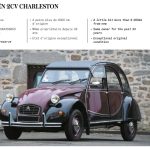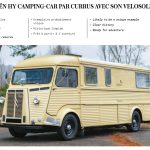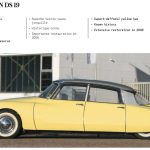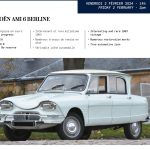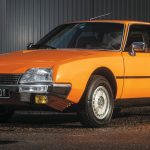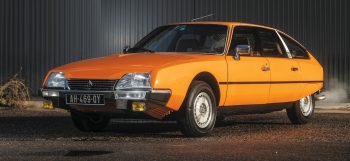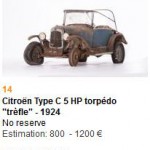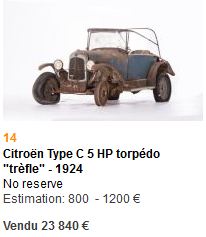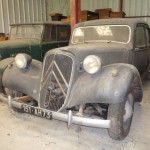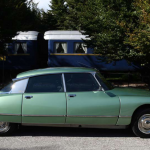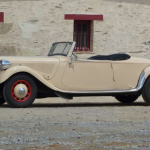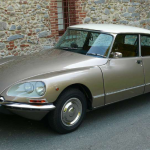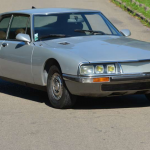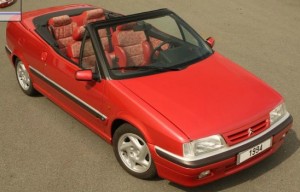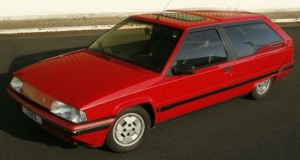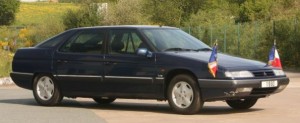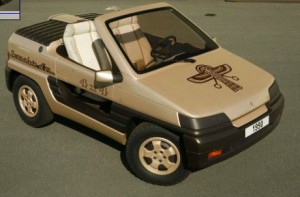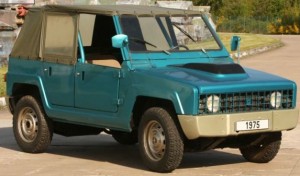(English below, en Francais au-dessous)
Einer der großen Namen der französischen Fahrzeug-Industrie ist sicherlich die Marke Trigano, vielen bekannt durch ihre Camping-Anhänger, die noch heute einen guten Ruf geniessen. André Trigano hat über Jahrzehnte hinweg auch eine Leidenschaft für historische Automobile entwickelt und viele Fahrzeuge gesammelt.
Rund 40 Citroën-Modelle aus seiner rund 140 Fahrzeuge umfassenden privaten Sammlung kommen in wenigen Tagen im Rahmen der Retromobile 2016 in Paris unter den Hammer. Versteigert durch Artcurial werden viele unterschiedliche Modelle aus etlichen Jahrzehnten Automobilbau, darunter frühe Modelle und Exoten wie ein Méhari 4×4, Citroën SM, DS Prestige, Citroën CX Prestige, 15-Six H (“Oléo”) bis hin zu einem wenige Jahre alten C6.
Der Online-Katalog von Artcurial enthält einige interessante Informationen, die über die Geschichte dieser einzigartigen Sammlung erzählen. Mit Zustimmung von Artcurial hier die deutsche Übersetzung des ansonsten original in engl./frz. Sprache unten zitierten Textes (C) Artcurial:
Der Verkauf von Citroën aus der Sammlung von André Trigano stellt ein besonderes Ereignis dar, da Trigano mit dem Sammeln von ihnen in den 1960er Jahren begonnen hat. Im Folgenden erzählt er über seine Leidenschaft.
“Le camping, c’est Trigano!” Wenn Sie vor 1980 geboren wurden und vielleicht französische Werbung mit verfolgten, haben Sie diesen Slogan sicherlich gehört. Er stammt von André Trigano, der mit seinem Vater Raymond und Bruder Gilbert maßgeblich zum Bedeutung der Campingbranche seit den 1930er Jahren und der Zeit des bezahlten Urlaubs beigetragen haben. Die Unternehmensgeschichte begann in einer kleinen Werkstatt zur Herstellung von Planen.
Der Beginn dieses großen industriellen Abenteuer verdient es, durch Trigano selbst erzählt zu werden: “Es war im Jahre 1936, einem Donnerstag Nachmittag, war ich in der Werkstatt und beobachtete meinen Vater und Bruder Gilbert. Eine Dame kam und sagte zu uns: “Mein Mann arbeitet bei Renault und jetzt, wo wir bezahlten Urlaub bekommen, möchten wir an die See reisen. Allerdings sind die Hotels zu teuer, also würde ich gerne Ihre Planen kaufen, als Unterschlupf.” Zelte für Camping nicht damals noch nicht vorhanden, mit Ausnahme der militärischen Versionen und solche für Bergsteiger. Mein Bruder antwortete: “Sie möchten also eine Art Zelt, ok. Wie viele sind Sie denn?” Die Dame erklärt, dass sie zu viert sein würden, und mein Bruder begann einen Plan zu skizzieren. “Und wir werden etwas Gepäck haben”, fügte die Dame hinzu. Also zeichnete mein Bruder noch einen Baldachin. “Und mein Mann ist ziemlich groß.” Das gab Gilbert die Idee, eine einseitig höhere Konstruktion zu entwerfen. Das wurde dann der Grundriss der Trigano-Zelte. “Gefällt es Ihnen so? Kommen Sie nächste Woche, und Ihr Zelt wird fertig sein.”
In der folgenden Woche kam die Dame zurück, um ihr Zelt abzuholen. Bereits eine Woche später kam sie wieder uns sagte: “Wir haben das Zelt in unserem Garten aufgebaut, und unsere Freunde kamen, um einen Blick darauf zu werfen. Sie meinten, es war fantastisch und nun will jeder eins. Das werden dann insgesamt 30 Zelte sein!” Und so begann die Herstellung von Trigano Zelten….”
Zu diesem Zeitpunkt entwickelte André Trigano bereits eine weitere Leidenschaft, nämlich die für das Automobil. Er erinnert sich noch heute an einen Packard im 17. Pariser Arrondissement, der aufgrund von fehlenden Ersatzteilen in Paris am Strassenrand herumstand. Dann kam der Krieg, und die Aktivitäten der Familie kamen zu einem abrupten Stillstand.
“Wir mussten Paris verlassen und gingen in den Süden, in die Gegend von Ariège”, erinnert sich André. “Ich war 14 Jahre alt und ich trat dem französischen Widerstand bei, das lag in meinem Naturell.” Eines Tages, am Ende des Krieges, sah er zum ersten mal einen Citroën Traction 11CV Cabriolet: “Das Cabrio war in Belgien registriert und stand in einer Hotelgarage, wo jemand es hinterlassen hate. Es war ein großartiges Auto, und war von der FTP [eine Widerstandsorganisation der französischen Résistance, Anm. der Amicale] bei der Befreiung eingesetzt gewesen. Es war damals von den höchsten Beamten benutzt worden, während ich mich mit einem Peugeot 402 begnügte, der nicht mehr benutzt worden war.” Der Anblick dieses beeindruckenden Cabriolets hinterließ einen bleibenden Eindruck auf ihn und damit zog ihn die Leidenschaft für den Doppelwinkel in seinen Bann. Doch zu dieser Zeit hatte die Familie Trigano ganz andere Sorgen: sie musste nämlich ihr Geschäft neu beleben. “Nach dem Krieg nahm das Interesse am Camping rasant zu. Mein Vater und Bruder Gilbert, der 15 Jahre älter als ich war, machte mich verantwortlich für die kommerzielle Seite unseres Geschäfts. Zu dieser Zeit entwickelte ich unseren Marken-Slogan “Le Camping, c’est Trigano”.
EIN DEBUT IM RALLYESPORT
Als das Geschäft anzog, hatte André Trigano endlich genug Geld verdient, um seinen Traum zu erfüllen, und sich ein Auto zu kaufen: zunächst war es ein Simca Huit und später dann ein Citroën. An diesem Punkt beschloss er, seine Glück im Rallyesport zu versuchen. Nach ersten Erfahrungen im Jahr 1951, als er an der Tour de France Automobile in einem Hotchkiss teilnahm, der allerdings aufgrund einer Panne bereits in Lourdes ausfiel, trat er in der Rallye Monte Carlo im folgenden Jahr an. “Ich hatte einen Second-Hand Austin A90 und einige Freunde empfohlen mir Georges Houel als Teamkollegen. Er war ein Motorradfahrer, die nun eine Karriere als Rennfahrer antreten wollte, und er erwies sich als ein echter Draufgänger – das war dann auch die einzige Veranstaltung, die ich mit ihm gemeinsam durchführte! Eigentlich waren wir aber ziemlich gut, wir erreichten Platz 11 der Gesamtwertung.”
André Trigano dann kaufte einen Traction Avant 15-Six und nahm mit ihm an mehreren Rallys teil. Doch nach dem Unfall seines Freundes Pierre Levegh in Le Mans im Jahre 1955 entschied er sich, sein Engagement in dieser Disziplin zu stoppen. “Aber ich hielt den Austin Healey, den ich fuhr. Und das war der Beginn meiner Sammel-Leidenschaft. Seitdem habe ich fast alle Autos die ich für den täglichen Gebrauch gekauft hatte auch behalten, aber kaufte dann auch einige Modelle die ich mochte oder für die ich eine besondere Vorliebe entwickelte.”
Citroën hat einen besonderen Platz in seinem Herzen. “Die Geschichte dieser Marke ist faszinierend und André Citroën war ein außergewöhnlicher Mensch. Er wusste, dass sich mit den besten Ingenieuren umgeben hatte, aber er war auch ein Visionär und er wusste, wie man verkaufte. Ich hatte die Chance, seine Tochter Jacqueline Citroën zu treffen, die mir viel aus seinem persönlichen Leben und seine dramatischen Ende erzählte. Danach entdeckte ich, dass wir bestimmte Dinge gemeinsam hatten, sowohl in unseren vorausschauenden Denken und wie wir mit Dingen umgingen. Um ein Beispiel zu nennen, so setzte er seinen Namen auf den Eiffelturm, während ich unseren Slogan in den Himmel mit mit dem Rauch von einem Flugzeug schreiben ließ. Er organisierte große Bankette mit seinem Agenten, und wir taten das gleiche mit unseren verbundenen Unternehmen, und sahen dies als einen Weg, um sie zu motivieren. Es bedurfte einer gewissen Kühnheit, sein Werk auf die Produktion von Automobilunzurüsten, kaum daß der erste Weltkrieg beendet war. Eine ähnliche Entwicklung direkt nach dem zweiten Weltkrieg entwickelten wir in unserer Familie, als unser Geschäft wieder ins Leben gerufen wurde und wir über die Produktion unserer Zelt und die Entwicklung der Tourismusbranche nachdachten, noch zu einer Zeit, als die meisten Leute damit beschäftigt waren, für ihr tägliches Brot zu sorgen. Diese gemeinsamen industriellen Bedürfnisse brachten mich näher an diese Marke…” So sehr, dass André Trigano eine eigene Citroën-Sammlung in seiner Sammlung von Automobilen entwickelte. “Um das Objekt mit dem Mann zu vebinden, ist dies eine außergewöhnliche Gelegenheit.”
DIE GANZE CITROËN MODELL-PALETTE
Mit über vierzig Autos heute umfasst die Sammlung fast jedes Modell, von 1919 bis in die 1970er Jahre, mit einem Schwerpunkt auf den 1930er und 1940er Jahren, Triganos Lieblings-Ära. Seine Autos haben alle eine Geschichte zu erzählen, oder erinnern ihn an ein bestimmtes Ereignis:
“Zum Beispiel besitze ich einen CITROËN C4 G Torpedo, das dem Modell, das wir während unserer Flucht verwendet hatten, entspricht. Unser Wagen war dann in der Nähe von Cahors zusammengebrochen und wir haben unsere Reise in einem CITROËN B14 durchgeführt, ein Modell, das ich später dann auch kaufte.” Ein Teil des Reise machte die Familie in der Begleitung eines später bekannten Sänger und Star auf dem Bildschirm, Serge Reggiani.
Wie bereits erwähnt war das Traction Cabrio bei der FTP im Einsatz, und nach dem Krieg entdeckte Trigano einen weiteren Citroën Traction Avant 11B Cabrio das genauso aussah wie das erste. Er machte sich auf die Suche nach dem Besitzer des Autos, und er konnte Herrn Magnol, einen Apotheker aus Foix, ausfindig machen, der das stattliche Cabriolet vor Jahren neu erworben hatte. Während des Krieges hatte Magnol das Auto vor der Requisition versteckt und konnte sogar dessen Diebstahl verhindern. Monseur Magnol fand Gefallen an André Trigano in einem solchen Ausmaß, dass er ihn als den Begünstigten an seinem Cabrio nach seinem Tod einsetzte. So kam das Auto im Jahr 1978 in die Trigano-Kollektion. “Er wollte, dass es an jemanden übergehen sollte, der sich darum kümmern würde. Dieses Auto hat das Werk im Juli 1939 verlassen, und meiner Meinung nach ist es das erfolgreichste Citroën-Modell, das jemals produziert wurde.” Dies ist das schönste Auto in der Sammlung.
Seine Verbundenheit mit dem Citroën Traction Avant 15-Six, einem Auto, das er besonders im Rallyesport einsetzte, ist manifestiert in verschiedenen Modellen, einschließlich einem seltenen Type Familiale sowie einem 15-Six H mit hydropneumatischer Federung auf der Hinterachse, die später dann im DS zu finden war. Er besitzt auch einen Citroën Traction Avant 7C Coupé aus dem Jahr 1935: “Zu der Zeit hieß es, dass dieses Auto das Geschenk eines Mann an seine Geliebte war, als die Beziehung beendet wurde. Ein sehr elegantes Auto, sehr weiblich!”
Bestimmte Fahrzeuge haben ihr Geheimnis gehalten, wie ein Citroën Rosalie den er auf einem Schrottplatz fand, und bei dem er sich immer wieder gefragt hatte, ob es als Taxi oder als Wagen mit Chauffeur eingesetzt gewesen war. “Das Interessante an dieser Limousine ist, dass ich einen Revolver in ihm fand. Was machte der denn da? Was die Rosalie anging, so sah ich einmal Jacqueline Citroën weinend vor diesem Modell stehen. Ihr Vater war sehr stolz darauf, erzählte sie mir.”
André Trigano war noch nie der Typ, der sich auf seinen Lorbeeren ausruhte, und zusätzlich zu seiner beruflichen Tätigkeit war er immer am öffentlichen Leben beteiligt. Im Jahr 2014 wurde er zum achten Mal als Bürgermeister seiner Gemeinde wiedergewählt, im Alter von 88 Jahren! “Jedes Mal, wenn ich eine Wahl gewonnen hatte, habe ich mir ein Auto gekauft”, erklärte er. “Ich habe sie alle gehalten, und natürlich gibt es Citroën unter ihnen, zum Beispiel ein CX Prestige. Im Gegensatz zu den meisten Politikern brauchte ich mich nie zu verstecken. Die Leute wissen um meine Geschichte und meine Leidenschaft.”
Die Sammlung umfasst auch neueren Modelle, wie beispielsweise ein M35-Prototyp mit Wankelmotor, ein Citroën SM Coupé mit Einspritzung und ein seltener BX 4TC, eine Rennmaschine mit Allradantrieb, entwickelt durch die Marke, um in der Gruppe B Rallye teilnehmen zu können. Es wurde ihm von der Fabrik Citroën übergeben. Und es gibt auch seinen Mehari 4×4 mit nur 1.705 km auf dem Tacho.
EINE GEMEINSAME LEIDENSCHAFT
“Sie können sich vielleicht erinnern, am Ende der 1970er Jahre gab es einen Exodus aus Vietnam mit vielen Bootsflüchtlingen. Wir begrüßten rund fünfzig von ihnen in unserem Dorf Mazères, und zu zweien entwickelte ich eine nähere Beziehung, die schließlich dazu führte, daß diese für die Sammlung arbeiteten. Einer von ist seitdem mein “Garage-Manager”, ein absolut vertrauenswürdiger Mann, der für die Wiederherstellung und Erhaltung der Fahrzeuge zuständig ist. Er ist genauso ein Perfektionist wie ich! Er hilft mir dabei, die Fahrzeuge so instand zu halten daß sie alle laufen. Wenn ich wieder nach Mazères komme, zum Wochenende hin, bereitet er stets zwei Autos für mich vor, darunter ein Citroën, und vorzugsweise solche, die gerade wiederhergestellt worden sind, damit ich mit ihnen fahren kann. Es sind etwa 30km von meinem Haus bis zum Rathaus und wir machen diese Reise stets in einem alten Auto.”
André Trigano wollte jedoch nie ein Museum eröffnen. “Ich konnte mir nicht vorstellen, mit meiner Leidenschaft Geld zu verdienen. Ich öffne die Sammlung kostenlos für die Besucher, vor allem Schulen und ältere Menschen.” Aber warum, mit einer solchen Leidenschaft, sollen die Automobile heute verkauft werden? “Ich bin 90 Jahre alt und habe zwei Söhne, die nicht daran interessiert sind”, erklärt er. “Die Aufrechterhaltung der Sammlung ist aufwendig und von 140 Autos, die ich besitze, habe ich beschlossen, rund 40 zu verkaufen. Das gibt uns die Mittel, die letzten Autos widerherzustellen, und in die noch Arbeit gesteckt werden soll. Und da es notwendig war, mich von etwas zu trennen, so entschied ich mich, ein zusammenhängendes Themen abzugeben, nämlich Citroën. Für den Moment, ich möchte die anderen Marken noch behalten, Delahaye, Lancia, …”
Spontan und voller Leben, liebt André Trigano es, seine Leidenschaft zu teilen. “Ich habe viel Glück gehabt. Natürlich musste ich zu bestimmten Zeiten eine Meinung konsequent vertreten, aber Sie wissen, wir sind alle gleich, und wenn Sie den Krieg überlebt haben, müssen Sie bescheiden bleiben.” In jedem Fall wird seine Entscheidung, sich von seinen Citroën zu trennen, Enthusiasten Gelegenheit geben, diesen interessanten Autos zu erwerben, darunter auch einige, dass er seit mehreren Jahrzehnten im Besitz hatte. Gut erhalten, haben sie alle eines gemeinsam: die Leidenschaft für die Marke, die sie zusammengeführt hat!

Soweit das Zitat aus dem Auktionskatalog.
Weitere Infos zur Versteigerung hier:
www.artcurial.com
bzw. Der Online-Kataog im direkten Ddownload (Kollektion Trigano ab Seite 203 ff.):
http://www.artcurial.com/pdf/2016/2877.pdf
Die zur Versteigerung kommenden Modelle (ca. 40 Fzg. aus der Trigano-Sammlung sowie noch rund 10 weitere Einlieferungen):
1920 CITROËN 10 HP TYPE A TORPÉDO
1922 CITROËN 5 HP TYPE C TORPÉDO
Ca. 1925 CITROËN B12 LIMOUSINE “WOODY”
1926 CITROËN 5 HP C3 TORPÉDO “TRÈFLE”
1926 CITROËN B12 TORPÉDO COMMERCIAL
1928 CITROËN B14 G LIMOUSINE
1929 CITROËN AC4 LIMOUSINE
Ca. 1929 CITROËN P19 CHENILLETTE KÉGRESSE
1930 CITROËN AC4 LIMOUSINE
1930 CITROËN C6 LIMOUSINE
1931 CITROËN C4 F BERLINE
1931 CITROËN C4 G COACH
1932 CITROËN C4 G TORPÉDO
1933 CITROËN C4 G MFP TORPÉDO
1934 CITROËN ROSALIE 8A COMMERCIALE
1934 CITROËN ROSALIE 8A BERLINE
1935 CITROËN TRACTION 7C COUPÉ
1936 CITROËN ROSALIE 11 UA LIMOUSINE
1936 CITROËN TRACTION 7C BERLINE
1939 CITROËN TRACTION 11 B CABRIOLET
1939 CITROËN TRACTION CABRIOLET 11 BL
1949 CITROËN TRACTION 15-SIX BERLINE
1952 CITROËN TRACTION 11 BL BERLINE
1953 CITROËN TRACTION 11 B BERLINE
1953 CITROËN TRACTION 11 BL BERLINE
1954 CITROËN TRACTION 15-SIX D FAMILIALE
1954 CITROËN TRACTION 15-SIX H BERLINE
1959 CITROËN 2 CV AZ
1961 CITROËN 2 CV SAHARA
1964 CITROËN 2 CV AK 350 FOURGONNETTE
1964 CITROËN AMI 6 BERLINE
1968 CITROËN ID 19
1968 CITROËN ID 21 F BREAK
1969 CITROËN AMI 8 BERLINE ET UN SOLEX
1969 CITROËN DS 21 M PRESTIGE
1969 CITROËN DS M 21 PALLAS
1971 CITROËN M35 PROTOTYPE N°417
1973 CITROËN AMI SUPER
1973 CITROËN SM INJECTION
1974 CITROËN DS 23 IE PALLAS
1976 CITROËN CX 2200 PRESTIGE
1980 CITROËN MÉHARI 4X4
1984 CITROËN VISA 1000 PISTES
1986 CITROËN BX 4TC
1987 CITROËN 2 CV AZKA
1988 CITROËN CX GTI TURBO 2
1990 CITROËN 2 CV 6 CHARLESTON
2007 CITROËN C6 V6 2.7 HDI SEDAN
Viel Spass beim Lesen – und viel Glück beim Ersteigern!
Dank noch einmal an Artcurial für die Überlassung der Informationen.
—–
Citroën Collection of André Trigano to be auctioned at Retromobile 2016
Around 40 vehicles which have been collected over the years by André Trigano, a family member of the famous camping manufacturer, will be for auction by Artcurial during the Retromobile 2016 fair in Paris.
From the catalogue the following excerpt about the story behind – thanks to / (C) by Artcurial:
The sale of Citroëns from the collection of André Trigano is a major event, as Trigano began collecting them in the 1960s. He talks about his passion.
“Le camping, c’est Trigano!” If you were born before 1980, you will have heard this slogan. It was created by André Trigano who, with his father Raymond and brother Gilbert, have been involved with the growth of camping since the 1930s and the era of paid leave. They started out in a small workshop producing tarpaulin. The beginning of this great industrial adventure deserves to be told, by the man himself: “It was in 1936, one Thursday afternoon, I was in the workshop, watching my father and brother Gilbert. A lady arrived and said to us: “My husband works at Renault and now that we get paid leave, we would like to go to the seaside. However, the hotels are too expensive, so I’d like to buy some canvas, as a shelter. “Tents for camping didn’t exist then, except for the military and mountain climbers. My brother replied “You’d like a kind of tent, then. How many of you are there? “The lady explained that they were four, and my brother started to sketch a plan. “And we will have some luggage, “added the lady. So my brother drew a canopy. “And my husband is quite tall. “This gave Gilbert the idea of giving it one vertical side that was higher. In fact that became the basic plan of the Trigano tent. “Like this? Come back next week and it will be ready. “The following week, the lady came to pick up her tent and a week later, she came back again to say: “We put the tent up in the garden and our friends came to have a look. They thought it was fantastic and everyone wants one. That will be 30 tents in all! “And that is how the manufacture of Trigano tents began. “At this time, André Trigano was already developing another passion, for the automobile. He still remembers today a certain Packard parked in the 17th arrondissement in Paris, inaccessible because of a lack of means. Then the war came, bringing the family’s activities to an abrupt halt. “We had to leave and go south, to Ariège, “recalls André. “I was 14 years old and I joined the resistance, as that was in my nature. “One day, at the end of the conflict, he came face to face with a Citroën Traction 11 CV cabriolet: “It was registered in Belgium and lay in a hotel garage where it had been abandoned. It was a magnificent car, used by the FTP during the Liberation ; it had been driven by the highest ranking officials, while I contented myself with a 402, that no longer moved! “The sight of this impressive cabriolet made a lasting impression on him and attracted him immediately to the marque of the double chevron. However, at this time, the Trigano family had other preoccupations: they had to relaunch their business. “After the war, camping took off. My father and brother Gilbert, 15 years older than me, put me in charge of the commercial side. That’s when I came up with the slogan “Le camping, c’est Trigano”.
A DEBUT IN RALLYING
As the business took off, André Trigano finally earned enough money to fulfil his dream, and buy himself a car: firstly a Simca Huit and then a Citroën. At this point he decided to try his hand at rallying. After his first experience in 1951, taking part in the Tour de France Automobile in a Hotchkiss that broke down at Lourdes, he entered the Monte Carlo rally the following year. “I had a second-hand Austin A90 and some friends suggested Georges Houel as a teammate. He was a motorcycle rider who wanted to start racing cars, but he proved to be a real daredevil and that was the only event I shared with him! That said, we did rather well, finishing eleventh overall.”
André Trigano then bought a Traction 15/Six, using it to take part in several rallies. However, following the accident of his friend Pierre Levegh at Le Mans in 1955, he chose to stop his involvement in this discipline. “But I kept the Austin Healey that I was driving. And that was the start of my collection. Since then, I have kept almost all the cars I’ve bought for everyday use, while also buying models I like or have a particular fondness for.”
Citroën has a special place in his heart. “The story of this marque is fascinating and André Citroën was an extraordinary man. He knew to surround himself with the best engineers, but he was also a visionary and he knew how to sell. I had the chance to meet his daughter, Jacqueline Citroën, who told me his story and its dramatic end. Subsequently I discovered that we had certain things in common, in our outlook and how we went about things. As an example, he inscribed his name on the Eiffel Tower, while I had our slogan traced in the sky, with the smoke from an aeroplane. He organised grand banquets with his agents, and we did the same with our affiliates, as a way to motivate them. It required a certain boldness to convert his factory to automobile production when the 1914 – 1918 had scarcely finished. The same could be said about our family, when we re-launched our tent and tourist business straight after the second world war, at a time when people were more preoccupied with getting enough to eat. These shared concerns brought me closer to this marque. “So much so that André Trigano created a collection within a collection, dedicated to the Double Chevron marque. “To unite the object with the man, that’s an extraordinary opportunity.”
THE WHOLE CITROËN RANGE
With over forty cars today, the collection has an example of nearly every model produced, from 1919 through to the 1970s, with an emphasis on the 1930s and 1940s, his favourite era. His cars all tell a story, or remind him of a particular event:
“For example, I have a C4 G Torpedo that corresponds to the model we used during the Exodus. We had broken down near Cahors, and carried on our route in a B14, a model I later bought as well. “One part of the journey was made in the company of a future singer and star of the screen, Serge Reggiani. We mentioned earlier the FTP’s Traction cabriolet, and after the war, Trigano spotted a Traction 11B cabriolet just like the first one he saw. He set off in search of the car’s owner who he discovered was a pharmacist from Foix, by the name of Magnol, who had bought the handsome cabriolet new. Hidden during the war, the car had escaped requisition and even been saved from a theft. Magnol took a liking to André Trigano to such an extent that he designated him the beneficiary of his cabriolet after his death. That is how the car came to be in Trigano’s collection in 1978. “He wanted it to go to someone who would look after it. This car left the factory in July 1939 and to my mind, it’s the most successful Citroën ever produced.” This is the most beautiful car in the collection.
His attachment to the Traction 15-Six, a car he particularly enjoyed rallying, is present in various models, including a rare family car and an Oléo version with rear hydro- pneumatic suspension that predates the DS. He also owns a stunning Traction 7C coupé from 1935: “At the time, it was said that this car was the gift a man gave to his mistress when they broke up! A very elegant car, very feminine.” Certain cars have kept their mystery, such as a Rosalie family car found at the breaker’s yard, which he has always wondered if it was a taxi or a chauffeur driven car. “What is interesting about this limousine is that I found a revolver in it, without its charger. What was it doing there? Concerning the Rosalie, I once saw Jacqueline Citroën crying in front of this model. Her father was very proud of it, she told me.”
André Trigano has never been the type to rest on his laurels, and in addition to his professional activities, he has always been involved in public life. In 2014 he was re-elected for the eighth time as mayor of his commune, at the age of 88 years! “Every time I have won an election, I have bought myself a car,” he declared. “I have kept them all, and naturally there are Citroëns amongst them, for example, a CX Prestige. Unlike most politicians, I don’t need to keep myself hidden away. People know my story and my passion.”
The collection includes more recent cars, such as an M35 prototype with rotary engine, an SM coupé with injection and a rare BX 4TC, a racing machine with four-wheel drive developed for the marque to participate in Group B. It was given to him by the factory. And there is also his Mehari 4×4 with just 1.705 km on the clock.
A SHARED PASSION
“You might remember perhaps, at the end of the 1970s, the business of the boat people fleeing Vietnam. We welcomed fifty into our village, Mazères, and I became very attached to two of them, who eventually came to work for the collection. One of them has become my garage manager, my trusted man who oversees the restoration and maintenance of the cars. He is as much a perfectionist as me! He also helps me keep them running. When I come back to Mazères, at the end of every week, he prepares two cars, one a Citroën, preferably ones that just have been restored, for me to drive. It is around 30 km from my home to the town hall and we do that journey in an old car.”
Generous with his cars, André Trigano has never wanted to open a museum. “I couldn’t imagine earning money from my passion. I open up the collection free of charge to visitors, especially schools and older people.” So, with such a passion, why sell today? “I am 90 years old and have two sons who aren’t interested in cars,” he explains. “Maintaining the collection is costly and out of 140 cars, I have decided to sell around 40, which will give us the means to restore the last cars needing work. And as it was necessary to lose something, I decided to pick a coherent theme, Citroën. For the moment, I will keep the other marques, Delahaye, Lancia…”
Spontaneous and full of life, André Trigano likes to share his passion: ” I have had a lot of luck. Of course, I have had to be pugnacious at times, but you know, we are all the same, and when you have been through the war and survived, you must remain modest.” In any case, his decision to part with his Citroëns will give enthusiasts access to these interesting cars, including some that he has owned for several decades. Sound and well preserved, they all have one thing in common: a passion for the marque that has brought them together!
More info about the auction at
www.artcurial.com
resp. the online catalogue here (page 203 ff.):
http://www.artcurial.com/pdf/2016/2877.pdf
Enjoy – and good luck to the bidders!
—–
Enchère de la Citroën collection du André Trigano sur Retromobile 2016
Sur la foire a Paris au commence du Fevrier 2016, ca. 40 voitures Citroën du André Trigano sont a vendre resp. a encherir. Nous avons la chance de vous informer grace a Artcurial – merci!
Regardez l’histoire des voitures – “quotation” du catalogue d’auction:
La vente des Citroën de la collection d’André Trigano est un évènement, car il a commencé à la constituer dans les années 1960. Il raconte sa passion.
“Le camping, c’est Trigano!” Si vous êtes né avant 1980, vous connaissez forcément ce slogan. Son auteur, c’est André Trigano qui, avec son père Raymond et son frère Gilbert, a accompagné le développement du camping en France dès les années 1930 et les congés payés, à partir d’un petit atelier de fabrication de bâches.
Le point de départ de cette superbe aventure industrielle mérite d’ailleurs d’être raconté, comme le fait notre interlocuteur: “C’était en 1936, année du Front Populaire, et j’étais un jeudi après-midi dans l’atelier, à regarder mon père et mon frère Gilbert. Est arrivée une dame qui nous a indiqué: “Mon mari est ouvrier chez Renault et, avec les nouveaux congés payés, nous avons envie d’aller à la mer. Mais l’hôtel est trop cher pour nous, alors j’aimerais vous acheter une toile, pour nous abriter.” Les tentes de camping n’existaient pas, sauf pour les militaires et les alpinistes. Mon frère à répondu: “Vous voulez une sorte de tente, en fait. Vous êtes combien de personnes?” La dame lui répond qu’ils sont quatre, et mon frère commence à faire un plan. “Et nous avons un peu de bagages,” ajoute la dame. Alors mon frère dessine une abside. “Et mon mari est assez grand.” Ce qui donne l’idée à Gilbert de tracer un côté vertical, avec la pointe plus haut. En fait, c’était déjà le plan de base de la tente Trigano. “Comme ça? Revenez la semaine prochaine, elle sera prête.”
La semaine suivante, la dame vient chercher sa tente et, encore une semaine plus tard, nous la voyons revenir et nous expliquer: “Nous avons monté la tente dans le jardin, et les camarades sont venus voir. Ils trouvent ça superbe et ils en veulent tous une. Ça fait 30 tentes en tout!” Et c’est ainsi qu’a commencé la fabrication des tentes Trigano.”
Mais à cette époque, André Trigano caresse déjà une autre passion, l’automobile et il garde encore aujourd’hui le souvenir d’une Packard garée à Paris, dans le 17e arrondissement, inaccessible par manque de moyens. Puis la guerre vient mettre un coup d’arrêt brutal à l’activité familiale. “Nous avons dû partir vers le sud, dans l’Ariège,” raconte André. “J’avais 14 ans et me suis engagé dans les partisans, parce que c’était dans ma nature.” A la fin du conflit, il tombe en arrêt devant un cabriolet Citroën Traction 11 CV: “Il était immatriculé en Belgique et avait été abandonné dans un garage d’hôtel où il était resté. C’était une voiture magnifique, que les FTP ont utilisé à la Libération; il était conduit par les plus gradés, et moi je me contentais d’une 402, qui n’avançait pas!” La vue de ce cabriolet l’impressionne durablement et l’attire irrémédiablement vers la marque au double chevron.
Mais à cette époque les préoccupations de la famille Trigano sont ailleurs; il faut relancer l’activité. “Après la guerre, le camping a démarré très fort. Mon père et mon frère Gilbert, de 15 ans plus âgé que moi, m’avaient chargé de la partie commerciale. C’est là que j’ai trouvé le slogan, “Le camping, c’est Trigano”.
DÉBUTS EN RALLYE
Comme les affaires prospèrent, André Trigano gagne enfin assez d’argent pour réaliser son rêve, acheter une voiture: d’abord une Simca Huit puis assez rapidement une Citroën. C’est à cette époque qu’il décide de se lancer dans le rallye automobile. Après une première expérience en 1951 au Tour de France Automobile avec une Hotchkiss qui casse à Lourdes, il s’engage l’année suivante au Monte-Carlo. “J’avais une Austin A90 d’occasion et mes amis m’avaient recommandé comme coéquipier Georges Houel. Il pratiquait la moto et voulait passer à l’automobile, mais il s’est révélé un vrai casse-cou, si bien que c’est la seule épreuve que j’ai partagée avec lui! Cela dit, nous avons obtenu un très bon résultat car nous sommes arrivés onzièmes au classement général.”
André Trigano fait ensuite l’acquisition d’une Traction 15/Six avec laquelle il participe à plusieurs rallyes. Mais en 1955, l’accident au Mans de Pierre Levegh, qu’il connaît, l’incite à mettre un terme à cette discipline. “Mais j’ai gardé l’Austin Healey que j’utilisais alors. Et c’est ce qui a constitué le début de la collection. Depuis, j’ai conservé pratiquement toutes les voitures que j’avais achetées pour mon usage quotidien, tout en faisant l’acquisition de modèles dont j’avais rêvé ou qui me plaisaient.”
De plus, la place de Citroën se confirme dans sa passion. “L’histoire de cette marque est fascinante et André Citroën était une homme extraordinaire. Il savait s’entourer des meilleurs ingénieurs, mais c’était aussi un visionnaire et il avait le don de la vente. J’ai eu la chance de rencontrer Jacqueline Citroën, sa fille, qui m’a raconté son histoire et sa fin dramatique. En plus, j’ai découvert par la suite certains points communs entre lui et nous, dans la façon de procéder et l’état d’esprit. Par exemple, il avait inscrit son nom sur la tour Eiffel, et de mon côté j’ai fait tracer dans le ciel notre slogan, avec un avion faisant de la fumée. Il organisait de grands banquets avec ses agents, et nous faisions de même avec nos affiliés, pour les motiver. Il lui a fallu de l’audace, pour convertir son usine à l’automobile alors que la guerre de 1914-1918 était à peine terminée. Et il en a fallu aussi à notre famille quand nous avons relancé notre commerce de tentes et de tourisme au lendemain de la seconde Guerre Mondiale, à une époque où les préoccupations étaient plutôt tournées vers le souci de manger à sa faim. Ces points communs m’ont encore rapprochés de cette marque.” Tant et si bien qu’André Trigano a constitué une collection dans la collection, consacrée au double chevron. “Pouvoir allier l’objet à l’homme, c’est une chance extraordinaire.”
TOUTE UNE GAMME DE CITROËN
Avec aujourd’hui plus de quarante voitures, la collection comporte pratiquement un exemplaire de chaque modèle produit, de 1919 jusqu’aux années 1970, avec une prédominance des années 1930/1940, sa période préférée. Ses voitures ont une histoire, ou lui rappellent un épisode particulier: “J’ai par exemple un torpédo C4 G qui correspond au modèle que nous avions utilisé pendant l’Exode. Nous étions tombés en panne vers Cahors, et avions poursuivi la route en B14, donc j’ai plus tard acheté aussi ce modèle.” Une partie du voyage s’effectuera en compagnie d’une future vedette de l’écran et de la chanson, Serge Reggiani.
Nous avons évoqué plus haut le cabriolet Traction des FTP et, après la guerre il repère un cabriolet Traction 11 B comme celui dont il rêve. Il part à la recherche du propriétaire et découvre qu’il s’agit d’un pharmacien de Foix, du nom de Magnol, qui a acheté neuf ce beau cabriolet. Caché pendant la guerre, il a échappé aux réquisitions et a même été sauvé d’un vol. Magnol se prend d’affection pour André Trigano à tel point qu’il le désigne comme bénéficiaire du cabriolet après son décès. C’est ainsi que la voiture rejoint en 1978 la collection Trigano. “Il voulait qu’elle soit chez quelqu’un qui en prenne soin. Cette voiture est sortie d’usine en juillet 1939 et je trouve que c’est la plus réussie de toutes les Citroën produites.” C’est la plus belle pièce de la collection.
Son attachement aux Traction 15-Six, voiture qu’il a particulièrement appréciée pendant ses rallyes, se manifeste par plusieurs modèles, dont une rare familiale et une version Oléo, celle dont la suspension arrière hydropneumatique préfigurait celle de la DS. Il possède également un ravissant coupé Traction 7C de 1935: “A l’époque, on disait que cette voiture était le cadeau qu’un homme faisait à sa maîtresse en cas de rupture! Une voiture très élégante, très féminine.” Certaines autos ont gardé leur mystère, comme une Rosalie familiale trouvée chez un casseur et dont il s’est toujours demandé s’il s’agissait d’un taxi ou d’une voiture de maître.
“La particularité de cette limousine, c’est que j’ai retrouvé dedans un revolver, sans chargeur. Que faisait-il là? D’ailleurs, à propos de Rosalie, j’ai vu un jour Jacqueline Citroën pleurer devant ce modèle. Son père en était très fier, m’a-t-elle dit.” André Trigano n’est pas du genre à rester les deux pieds dans le même sabot et, en plus de ses activités professionnelles, il s’est impliqué dans la vie publique et a été réélu en 2014 pour la huitième fois maire de sa commune, alors qu’il était âgé de 88 ans! “Chaque fois que j’ai remporté une élection, je me suis offert une voiture,” avoue-t-il. “Je les ai toutes gardées, et il y a bien sûr des Citroën dans le lot, comme par exemple une CX Prestige. Contrairement aux hommes politiques, je n’avais pas besoin de me cacher, les gens connaissait mon histoire et ma passion.”
La collection comporte des pièces plus récentes, comme un prototype M35 à moteur rotatif, un coupé SM à injection ou une rare BX 4TC, machine de course à transmission intégrale mise au point par la marque pour s’engager en Groupe B. Elle lui a été donnée par l’usine. Et sa Méhari 4×4 n’affiche que 1.705 km!
UNE PASSION PARTAGÉE
“Vous vous souvenez peut-être que, à la fin des années 1970, il y a eu l’affaire des “boat-people”, qui fuyaient le Viêt-Nam. Nous en avons recueilli 50 dans notre village de Mazères et je me suis attaché à deux d’entre eux, qui sont venus finalement travailler dans la collection. L’un d’eux est devenu mon chef de garage, mon homme de confiance et il gère les restaurations et l’entretien des autos. Il est aussi perfectionniste que moi! Il m’aide aussi à les faire rouler. Quand je rentre à Mazères, toutes les fins de semaine, il prépare deux voitures, dont une Citroën, et de préférence qui sortent de restauration, pour les essayer. Il y a environ 30 km entre mon domicile et la mairie et nous les parcourons en voiture ancienne.”
Généreux de ses voitures, André Trigano n’a jamais souhaité ouvrir un musée. “Je ne pouvais pas imaginer gagner de l’argent avec ma passion. Alors j’ai ouvert la collection gratuitement aux visites, en particulier aux écoles et aux aînés.” Alors avec une telle passion, pourquoi vendre aujourd’hui? “J’ai 90 ans et deux fils qui ne s’intéressent pas à l’automobile,” explique-t-il. “L’entretien de la collection est coûteux et, sur mes 140 voitures, j’ai décidé d’en vendre une quarantaine, ce qui nous donnera les moyens de restaurer les dernières qui ne sont pas en état. Et comme il fallait se couper de quelque chose, j’ai choisi un thème cohérent, Citroën. Pour le moment, je garde les voitures d’autres marques, Delahaye, Lancia…”
Spontané et pétillant, André Trigano partage volontiers sa passion: “J’ai eu beaucoup de chance. Bien sûr, j’ai dû montrer de la pugnacité, mais vous savez, nous sommes tous pareils et quand on a vu la guerre et qu’on s’en est sorti, il faut rester modeste.” En tout cas, sa décision de se séparer de ses Citroën va permettre aux amateurs d’avoir accès à des voitures intéressantes, dont certaines sont entre ses mains depuis plusieurs dizaines d’années. Saines et bien préservées, elles ont un point commun: c’est la passion de la marque qui les a réunies!
Plus d’info sur l’enchère a
www.artcurial.com
resp. le catalogue en direct download (pages 203 ff.):
http://www.artcurial.com/pdf/2016/2877.pdf
Amusez-vous – et bonne chance!
